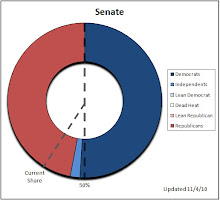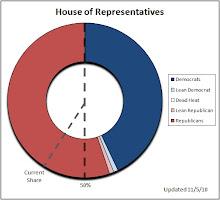First of all, the conventional media storyline of Mitt Romney being the frontrunner is certainly true. His position in the polls has remained consistently well ahead of the pack. Still, his lead is not nearly as strong as it would seem. The latest polling averages from RealClearPolitics.com show Romney with a lead of 11.6 over Sarah Palin, who hasn't yet declared her candidacy. Among declared candidates, the closest is Herman Cain, who trails Romney by 15 percentage points.
To put this lead in perspective, at this time four years ago, Rudy Giuliani had a lead of 7.4 percentage points over the next closest opponent, Fred Thompson. He led eventual nominee John McCain by 9.7 percentage points. Mike Huckabee, who would eventually finish second in the primaries, was only just beginning to register with 2.8% support, trailing Giuliani by 23.4 percentage points.
To be sure, there is no way of knowing whether a complete campaign failure the likes of what Giuliani went through is on the horizon for Team Romney. He is more vetted than Giuliani was. Giuliani had never run for office above the level of Mayor. Mitt Romney ran a campaign for President last time around. Still, Romney has the ghosts of his Massachusetts health care debacle and his position flipping on the issue of abortion lurking in his closet.
Is Romney the favorite to win the 2012 GOP nomination? Yes. Would I put down money on it? No. There is still a LOT left to play out.
So who is positioning himself (or herself) to be the most likely alternative to Mitt Romney in the end? I will size up the competition using two different measures. First, I will use an average of support in the 3 most recent polls published. This is the most conventional measure to get at the relative standing of the candidates. At this point in the campaign, though, I would like to control a little for the fact that the frontrunners (as in the case with Giuliani) are in that position at least in part because of a head start in name recognition. Theoretically, if everybody knows your name, even if a considerable portion of them don't like you, you will gain more support than a candidate everybody loves, they just haven't heard much about yet. Further, as the campaign goes on and this advantage is somewhat neutralized (especially in early primary states which are targeted by all of the campaigns in order to increase name recognition substantially), this head start becomes less and less determinative in the early primaries and caucuses.
Using the first method, simple support in the 3 most recent polls, the standings look like this:
1. Mitt Romney - 27%
2. Sarah Palin - 13%
3. Rick Perry - 11%
4. Michelle Bachmann - 10%
5. Herman Cain - 9%
6. Ron Paul - 6%
7. Newt Gingrich - 6%http://www.blogger.com/img/blank.gif
8. Tim Pawlenty - 5%
9. Rick Santorum - 4%
10. Jon Huntsman - 2%
11. Gary Johnson - 1%

Using an alternative method, the standings look a little different. In order to control for limited name recognition, I have created a score which takes the overall support in the 3 most recent polls and divides it by name recognition, as measured by Gallup. In effect, it compares candidates based on what their support would be if they had 100% name recognition. Additionally, it assumes that those that don't know about the candidate are just as likely to support the candidate as those that already do. While this assumption has its faults, I believe the measure still provides interesting insight into the campaign. Using this method, the candidates are positioned thusly:
1. Mitt Romney - 32%
2. Herman Cain - 20%
3. Michelle Bachmann - 14%
4. Sarah Palin - 13%
5. Tim Pawlenty - 9%
6. Ron Paul - 8 %
7. Rick Santorum - 7%
8. Newt Gingrich - 7%
9. Jon Huntsman - 4%
10. Gary Johnson - 3%
** Rick Perry has not yet been included in Gallup polls, therefore there is no similar measure for name recognition. Thus, he has been left out of these rankings.
** Percentages do not add up to 100% because support is inflated for all candidates in order to estimate what it would be if each had 100% name recognition.

Obviously, the true positioning probably lies somewhere between these two measures. Name recognition will not remain low for all of these candidates. It also won't reach 100% for anybody. Therefore, I am going to average the two rankings for all of the candidates to get a medium measure of reasonable expectations. The following table summarizes this.
Support Score Average
Mitt Romney 1 1 1
Rick Perry 3 n/a 3
Sarah Palin 2 4 3
Herman Cain 5 2 3.5
Michelle Bachmann 4 3 3.5
Ron Paul 6 6 6
Tim Pawlenty 8 5 6.5
Newt Gingrich 7 8 7.5
Rick Santorum 9 7 8
Jon Huntsman 10 9 9.5
Gary Johnson 11 10 10.5
So what can we gather from all this? Well, Sarah Palin and Rick Perry have an opportunity to completely scramble the race. In there absence, though, Herman Cain and Michelle Bachmann are in strong position to battle it out for the anti-Romney spot. In the end, Iowa and South Carolina could serve to decide between these two should Rick Perry or Sarah Palin either decide not to run or enter the race to less than stellar reviews. In the mean time, Romney must hope that he can hold on to the top spot, unlike Giuliani four years ago.



















